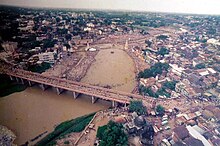Nashik-Trimbakeshwar Simhastha
| Nashik-Trimbakeshwar Simhastha नाशिक-त्र्यंबकेश्वर सिंहस्थ कुंभमेळा |
|
|---|---|

1989 Kumbh Mela at Nashik
|
|
| Status | active |
| Genre | Fair |
| Frequency | Every 12 years |
| Venue | Banks of Godavari river |
| Location(s) | Trimbak and Nashik |
| Country | India |
| Previous event | 2015 |
| Next event | 2027 |
| Participants | Akharas, pilgrims |
| Website | |
| kumbhmela2015 |
|
Nashik-Trimbakeshwar Simhastha is a Hindu religious mela held every 12 years in the Nashik district of Maharashtra, India. The name of the festival is also transliterated as Sinhastha or Singhastha. It is one of the four fairs traditionally recognized as Kumbha Melas, and is also known as Nashik-Trimbak Kumbha Mela or Nashik Kumbha Mela.
The fair involves ritual bathing on the banks of Godavari river, at the Trimbakeshwar Shiva Temple (in Trimbak) and the Ram Kund in Nashik. Until 1789, the fair was held only at Trimbak, but after a clash between Vaishnavites and Saivites, the Maratha Peshwa segregated the Vaishnavites to the Nashik city.
According to Hindu mythology, Vishnu dropped drops of amrita (the drink of immortality) at four places, while transporting it in a kumbha (pot). These four places, including Nashik, are identified as the present-day sites of the Kumbh Mela. The age of the Nashik-Trimbak Simhastha is uncertain, but its association with the kumbha myth is relatively recent, dating back to the 20th century. The Nasik District Gazetteer published during the 19th century does not mention the term "Kumbh Mela" to describe the local Simhastha fair. The earliest extant texts that contain the name "Kumbha Mela" are Khulasat-ut-Tawarikh (1695 CE) and Chahar Gulshan (1789 CE). Both these texts use the term "Kumbh Mela" to describe only the Haridwar Kumbh Mela, although they mention the Simhastha fair at Nashik. It appears that the Nashik Simhastha adapted the kumbh myth (and the name Kumbh Mela) from the Haridwar Kumbh Mela. The Ujjain Simhastha, in turn, is an adaptation of the Nashik-Trimbak Simhastha: it began in the 18th century, when the Maratha ruler Ranoji Shinde invited ascetics from Nashik to Ujjain for a local festival.
...
Wikipedia
